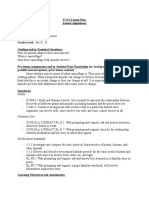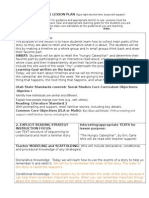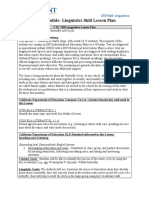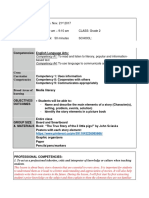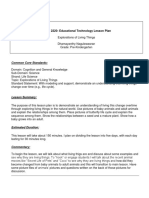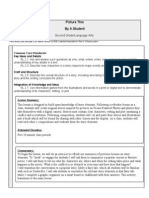0 ratings0% found this document useful (0 votes)
65 viewsEdu 3460-Lesson Plan
Edu 3460-Lesson Plan
Uploaded by
Kat22341. This lesson plan teaches kindergarten students about sequencing events in a story by reading Eric Carle's "The Very Hungry Caterpillar".
2. Students will learn about the beginning, middle, and end of the story and practice sequencing the events through discussion, illustrations, and sentence strips.
3. The lesson incorporates guided practice where students help sequence events and create their own "caterpillar bags" by cutting out and gluing pictures of food in the correct order.
Copyright:
© All Rights Reserved
Available Formats
Download as DOC, PDF, TXT or read online from Scribd
Edu 3460-Lesson Plan
Edu 3460-Lesson Plan
Uploaded by
Kat22340 ratings0% found this document useful (0 votes)
65 views8 pages1. This lesson plan teaches kindergarten students about sequencing events in a story by reading Eric Carle's "The Very Hungry Caterpillar".
2. Students will learn about the beginning, middle, and end of the story and practice sequencing the events through discussion, illustrations, and sentence strips.
3. The lesson incorporates guided practice where students help sequence events and create their own "caterpillar bags" by cutting out and gluing pictures of food in the correct order.
Copyright
© © All Rights Reserved
Available Formats
DOC, PDF, TXT or read online from Scribd
Share this document
Did you find this document useful?
Is this content inappropriate?
1. This lesson plan teaches kindergarten students about sequencing events in a story by reading Eric Carle's "The Very Hungry Caterpillar".
2. Students will learn about the beginning, middle, and end of the story and practice sequencing the events through discussion, illustrations, and sentence strips.
3. The lesson incorporates guided practice where students help sequence events and create their own "caterpillar bags" by cutting out and gluing pictures of food in the correct order.
Copyright:
© All Rights Reserved
Available Formats
Download as DOC, PDF, TXT or read online from Scribd
Download as doc, pdf, or txt
0 ratings0% found this document useful (0 votes)
65 views8 pagesEdu 3460-Lesson Plan
Edu 3460-Lesson Plan
Uploaded by
Kat22341. This lesson plan teaches kindergarten students about sequencing events in a story by reading Eric Carle's "The Very Hungry Caterpillar".
2. Students will learn about the beginning, middle, and end of the story and practice sequencing the events through discussion, illustrations, and sentence strips.
3. The lesson incorporates guided practice where students help sequence events and create their own "caterpillar bags" by cutting out and gluing pictures of food in the correct order.
Copyright:
© All Rights Reserved
Available Formats
Download as DOC, PDF, TXT or read online from Scribd
Download as doc, pdf, or txt
You are on page 1of 8
LESSON PLAN DESIGN
1. Author - Kathryn Grundner
2. Title - Sequencing: The Very Hungry Caterpillar
3. Grade level: Kindergarten
Common Core Standard:
K.R.2 Key !dea" and #etail"
2. With prompting and support, retell familiar stories, including key details.
$ichigan %ducational Technology Standard" &or Student" '$%TS-S( 2))*:
+K-2.C!. Creativity and !nnovation
+K-2.C!.1.
use a variety of digital tools (e.g., word processors, drawing tools, simulations,
presentation software, graphical organizers) to learn, create, and convey
original ideas or illustrate concepts.
,. Rationale - When working one on one with students, or in guided reading groups, way
too often I find that, although the student is reading, they are not comprehending the
story. I believe that kindergarten is where the foundation starts and think that a simple
story such as the one I use in this lesson plan, will help the students understand the
importance of reading comprehension. o continue working on se!uencing, I know that
"ric #arle has other books that will be useful, and I would be able to e$plore the topic
more, and be able to e$pand students% understanding of the concept %se!uencing%. It%s great
if a student is reading letters and words, but it%s even better if they are understanding what
they are reading&
-. +rerequi"ite S.ill" -
'. he student must be able to read ( at a certain level (basic words)
2. he student must be able listen
). he student must be able to write
*. he student must be able to use scissors
+. he student must be able to follow directions
/. Antici0atory Set '&ocu"( 1
'. ,ave students sit together on the floor in a group. -timulate a discussion by asking the
students what a typical school day is like in .rs. /rundner%s classroom. What happens
in the beginning of the day0 In the middle of the day0 and at the end0
2. 1o you think that each day we do things in an order0 (/et up in the morning, brush our
teeth, eat breakfast, etc.
). Who can tell us what order they did things in today0
*. 1o you think that everyone has an order to how they do some things each day0 What
about animals0 1o they have an order0 What do you think a caterpillar does
1
each day0 What types of food do you think they eat each day0 1o you think they
have breakfast, snack, lunch and dinner like we do0
+. ell students that today they are going to learn more about a very special caterpillar
and his order of events during the week, but first lets learn more about what it
means beginning, middle, end in a story.
2. The e""on +lan Goal and 345ective'"( and +ur0o"e - he purpose of the lesson is for
students will be able to discuss events of a story at the beginning, middle, and end. They
will also learn the concept and word of 'sequence' and be able to sequence the events in
the story "A Very Hungry Caterpillar"
345ective
'. 2fter reading the book "The Very Hungry Caterpillar3, with pre4cut out
pictures, the students will be able to verbally retell the se!uence of
events, in order to pass this task a student must be able to correctly put all
five out of the seven events in order.
2. /iven a chart and marker, the students will be able to verbally identify the
concept of 3beginning, middle, and end,3 in order to pass this task the student
must be able to two of the three terms in proper order.
). /iven a smart board and sentence strips, a student must be able to put the
sentences in correct order, in order to pass a student must demonstrate proper
behavior and correct use with the -mart 5oard.
6. !n"tructional !n0ut -
'. eacher will talk about how certain words and phrases in a story give clues about
whether it is at the beginning, middle, or end. he teacher will make a list of words on
the board and discusses with the students where these words and phrases would be
found6at the beginning, middle, or end. 2nother hint that the teacher will tell is that if
it%s not clearly the beginning or the end, it%s probably the middle. he chart on the board
will look like this7
7eginning $iddle %nd
8nce upon a time... he ne$t day... hey lived happily ever after.
,enry was born... 2fter several months... In the end...
2. eacher will also discuss the terms first, second, and last. he teacher will e$plain that
these words can be used to e$plain the order of a story. he teacher will then add those
terms to the chart on the board.
). Introduce the book The Very Hungry Caterpillar asking students to really listen to the
story and try to find the beginning, middle, and end. 2s the teacher reads, pause to
identify the parts of the te$t. 9or instance, before reading the first page the teacher will
say, 3:et%s see what happens at the beginning of the book.3 When you get to the part
where the caterpillar begins to eat you might say, 3,ere comes the middle of the story.3
9inally, as the caterpillar builds his cocoon you might wonder aloud, 3I think this is the
ending of the book.3 2fter you have read the book, draw a three4column chart on the
board, with the column labels, 35eginning,3 3.iddle,3 and 3"nd.3
2
*. $odeling '"ho8( -
-ince you are modeling this for students, think aloud while you say something such as,
3What happened at the beginning of The Very Hungry Caterpillar0 Well, in the
beginning, there was an egg. he caterpillar was born in the beginning of the story. :et%s
see. I%ll look back at the book to find out what else happened at the beginning of the story.
2t the beginning of the story, it was -unday.3
;ecord these ideas in the 35eginning3 column of your chart.
here was an egg.
he caterpillar was born.
It was -unday
1). Chec.ing 9or :nder"tanding 'C9:( -
,ave the students line up at the door. 2sk the students who is at the beginning of
the line, have those students raise their hands. hen ask the students who are in
the middle to stand on one foot. 9inally ask the students at the end of the line to
touch their nose. 8nce this is complete have the students back to the carpet. his
!uick activity will allow me to see if the children are grasping the concept, or if
they are struggling. If they are struggling then I know from this that I may need to
back it up, and model or instruct more.
11. Guided +ractice '&ollo8 me( -
'. #omplete the ne$t part of the chart with students, asking the !uestion, 3What happened
in the middle of the story0 What happened at the end of the story03
7eginning: he caterpillar was born and was hungry. $iddle: "ach day the caterpillar
ate a little more than the day before. %nd: he caterpillar changed into a butterfly.
2.he teacher will then read a few sentence strip from the story out loud and 3:T of
order. he students should realize the mistake and help put the sentence strips of the story
in the correct order from beginning to end.
). he sentence strips will then be distributed to students as well as the illustrations that
go with it. We will re4read the story and after each event, the teacher will re!uest the
correct sentence strip and illustration be brought up and put into the 3#lassroom
#aterpillar3 displayed in the correct order.
*.eacher and class will then go over in order what the caterpillar had eaten.
+. eacher will then tell the class they are going to make their own classroom caterpillars
like the one the teacher has made.
<. he teacher will have already at the tables paper bags, caterpillar pictures, and food.
he students will need to cut around the caterpillar and glue it to the outside of the bag.
=. he teacher will demonstrate first how to cut around the caterpillar and glue it on. he
students will then be instructed to cut around the food pictures, and the teacher will show
them the already cut out e$amples, she has already used.
Chec.ing &or :nder"tanding:
'. 5efore children go back to their seats, the teacher will have the students give a thumbs
up if they totally understand the beginning, middle and end of the caterpillar story. 2
thumbs down if no, they don%t understand it at all. 2nd a sideways thumb if they sort of
understand, but need more practice.
3
#i&&erentiation o& !n"truction7 he class can be separated into three groups to form
35eginning,3 3.iddle,3 and 3"nd3 groups. 5e specific about where the groups will start and stop
their portions of the story. 9or instance, the 35eginning3 group could start the story with the
caterpillar being born from an egg, and that it started on a -unday. he 3.iddle3 group could
write about what the caterpillar ate on each day of one week. he 3"nd3 group could write about
the caterpillar becoming so full, making a cocoon and then waking up a butterfly. he more
advance students will have the opportunity to begin writing the words of the story, underneath
the illustrations, and the student that may need more assistance will be able to collaborate with
peers in the small group and receive e$tra scaffolding from the teacher.
12. !nde0endent +ractice -
9or independent practice, the students will identify events in the beginning, middle, and
end of the story, by cutting out the foods, and putting them in the 3caterpillar bag3 in the
correct order. 8nce they have all the prepared food pictures cut out. hey will work with
a partner retelling the story, using the words they have >ust learned? such as beginning,
middle, end, first, second, and last.
13. Clo"ure -
he class will gather back at the rug and listen to certain classmates share their work.
here is a classroom schedule of students who share their work on certain days. he
chosen student will speak loudly and clearly, and once they are done sharing their
understanding of the story, the student will pick from our classroom cheer%s and the class
will perform that cheer. -uch as 3a round of applause3 where the class claps in a round
circle for three times.
1,. Technology - he technology that I would infuse in this lesson plan, would be the use of a
smart board, and to work with the software that goes along with it. he use of the smart board
fits into the curriculum, for it is allowing the students the opportunity to use a variety of digital
tools (e.g., word processors, drawing tools, simulations, presentation software, graphical
organizers) to learn, create, and convey original ideas or illustrate concepts (technology
standard). Instead of having the sentence strips cut out, I would have them on the smart board,
and the students would be able to in groups or individually be able to put them in the correct
order. When using the smart board, the students would be able to verbally tell me, or interact
with the material on their own. With the infusion of this technology this will enhance my lesson
plan immensely. It will allow the students to interact with the words@sentences. It will allow me
to keep things neat and allow both myself and the students to think creatively. he smart board
will let the students take a leading role in their learning. If one student finds it easier to circle or
number the correct sentence strips, they can. If another student wanted to move the sentences
around and place them in order that way4the smart board allows them to do that as well. 8ver all
the integration of this technology within my lesson will open door for many other teachable
moments.
a. he smart board will be used during the guided practice, at first. 5ut once it is
modeled, students will have access to it throughout the morning of literacy time.
he guided practice will allow one student at a time to volunteer to demonstrate
their knowledge, but after that will be in literacy groups.
b. I want my students to gain the understanding that technology is a useful tool in
helping us learn. I want them to feel comfortable with the smart board, and to be
able to use a method they feel more comfortable in. 1uring literacy time we have
centers, and a computer center is a part of that. -ince we are working on
se!uencing, all options that week, will be websites, games, and pattern books on
se!uencing. 2s mentioned before, out of this lesson, and technology, my main
4
goal is the students to become familiar with it, and to see it as a resource instead
of >ust a computer to play with.
c. ;esources that I would need would be the smart board, the computer center, and
the imaginations and attention of my students.
d. he first day of school, the kindergartners will be e$posed to the smart board. I
would have it for lunch count, and apart of morning message. I would model and
instruct how to use the smart board, and provide numerous times a day for the kids
to have access to the board. .y whole literacy centers will take a week or so to
demonstrate how it should look, and what I e$pect from them. 8nce they get a hang
on the computer center, then I would model any new programs or websites, I would
like them to try that day.
e. !nclude at lea"t t! eb"ite"
1. htt0:;;888.the.id<0age.com;&ree.id"game";game";nggame";"equence-
memory-game.html
2. htt0:;;888.turtlediary.com;.indergarten-game";e"l-e&l-game";0icture-
"equencing.html
hese are two websites that allow children to practice the concept of se!uencing
through the use of interactive games. I would model these sites to the children, then
allow access to them at the computer literacy center. I would even have the games
available on the smart board throughout the morning, and allow groups of three or less
to play on the smart board. hrough these two websites, children will hopefully see
that technology can serve as a fun resourceful tool, and will want to continue to use
more of it, and e$pand on a higher level of thinking.
1-. $aterial";Re"ource"
The Very Hungry Caterpillar, by "ric #arle
2 chalkboard, white board, or chart paper to record information from the te$t
Small brown paper bags, Scissors, caterpillar templates
$ore $aterial" needed7 Aotebook (or whatever -mart 5oard software), already made
sentence strips to be placed out of order and needed to be se!uenced in order.
1/. Time 9rame -
I would introduce this lesson during our literacy time, which would typically be in the
morning and a two hour block. I would give at least two4three days for this lesson plan.
his will allow enough time to interactively read the story aloud in a large group, then
5
time to read independently, or in partners. ime to gain the concept of the new
vocabulary, and to have time to make and share their caterpillar bags, have time on the
se!uencing websites, and work on the smart board with the sentence strips.
12. Activitie";+rocedure -
'. 2nticipatory -et4 /et the kids minds going, asking !uestions. Brepare them for what
we are going to be learning about.
2. Csing the #hart on the white board@ or -mart 5oard begin talking about beginning,
middle, end. Brovide e$ample words, give e$amples, fill in the chart. eacher will also
discuss the terms first, second, and last. he teacher will e$plain that these words can be
used to e$plain the order of a story. he teacher will then add those terms to the chart on
the board.
). ;ead the story 3A Very Hungry Caterpillar."
*. 2fter you have read the book, draw a three4column chart on the board@ -mart 5oard,
with the column labels, 35eginning,3 3.iddle,3 and 3"nd.3
+. Duick check for understanding4 have students stand in line activity
<. 5ack to carpet
=. 5ack to the story, have the students help you fill in the chart.
E.8n smart board show sentence strips out of order and have the students help you put
them back in the correct se!uence.
F. eacher will then tell the class they are going to make their own classroom caterpillars
like the one the teacher has made.
'G. he teacher will have already at the tables paper bags, caterpillar pictures, and food.
he students will need to cut around the caterpillar and glue it to the outside of the bag.
''. he teacher will demonstrate first how to cut around the caterpillar and glue it on.
he students will then be instructed to cut around the food pictures, and the
teacher will show them the already cut out e$amples, she has already used.
'2. #heck for understanding4 thumbs up or down
'). /et children into their assigned literacy groups
'*. he caterpillar bags will be at three centers and then another center will be computer
center with two se!uencing games they can practice with.
'+. #enter time4 groups work on bags or computer se!uencing websites on computer or a
group on the smart board.
'<. 8nce they have all the prepared food pictures cut out. hey will work with a partner
retelling the story, using the words they have >ust learned? such as beginning, middle,
end, first, second, and last.
'=.2ssessment4on going observations and rubric
'E. #losure4 -haring of the bags and classroom cheer&
'F. ;eflection4 What I would of changed0 What worked well0 What I liked@ disliked
16. +er&ormance A""e""ment -
=>o8 8ill ! .no8 that my in"truction 8a" "ucce""&ul?@ 8bservation between the
partner sharing, and the classroom sharing time, will allow me to assess the students to
see if they have mastered the se!uence of the story. .y continuous use of %checking for
understanding3 is also a way I will be assessing my students progress.
=#id the de"igned le""on 0lan meet the intended o45ective"? 5ased on the rubric below I
will be able to identify if the student has reached the intended ob>ectives.
9ormative: 8bservation between the partner sharing, and the classroom sharing time,
will allow me to assess the students to see if they have mastered the se!uence of the
6
story. he use of checking for understanding, observation during guided practice, and
center time will allow me to appropriately assess the students progress.
Summative: o be able to assess student understanding of the se!uence of a story, I
would use my rubric below and have each student share their caterpillar bag with myself
or a parent helper@ adult helper and test each student on the se!uence of the story.
Not Yet
Mastered
0
Needs
Improvement
1
Meets
Requirements
3
Proficient
5
SCORE
Out of
15
Student is able to
properl use t!e
terms "be#innin#$
middle and end%"
Cannot master
any of the three
terms
#an only master one
of the three terms
#an master t8o
out of the three
terms
Is able to
identify
A three
terms
&!e student is
able to properl
use t!e
tec!nolo# and
can see its
purpose 'it!in t!e
lesson%
#annot
properly use
the technology
and see%s no
purpose
Is able to use the
technology partially,
and has not made a
connection with its
purpose
Is able to use
the technology
partially, and
has made a
connection with
its purpose
,as
mastered
the tools
used in this
lesson, and
has made a
connection
with the
purpose of
technology
Sequencin# #an master one
of the se!uence
to the story
Is able to correctly
match three of the
seven se!uences in
the story
Is able to match
&ive out of the
seven se!uences
in the story
Is able to
match A
the
se!uences
in the story
1*. 9ollo8-u0;%Aten"ion Activity - I would make se!uencing and pattern books a week long
activity. o follow up with this activity I would choose a different, familiar book and ask students
in guided reading groups to identify the beginning, middle, and end of that story. -tories such as
3Brown Bear, Brown Bear". 2nother activity could be carried into science and you can use the
stages of a butterfly, using the same book, >ust different idea.
2). Re&lection" o& your le""on 0lanB
he format and preparation of this lesson plan went smoothly. I found all the e$tra
time to share and discuss with classmates useful and a confident builder. I think that the
integration of the -mart 5oard enhanced this lesson, and also the two websites with
interactive activities served useful and fun. I was able to see through this 2' component
lesson plan design how much work it takes to have a %complete% lesson and the value it will
serve for all my students. hrough this pro>ect and class, I am more confident in my
7
capabilities as a future teacher. I also encourage and appreciate technology so much more,
and pray that I will be in a district that will also see the importance of technology, the way I
do.
21. Re&erence'"(
#arle, ". ('FE=). The Very Hungry Caterpillar. Aew Hork, AH7 Bhilomel 5ooks.
-e!uencing7 he ,ungry #aterpillar (2GGG). In Teacher Vision. ;etrieved 9ebruary 2G,
2G'), from http7@@www.teachervision.fen.com@skill4builder@lesson4plan@*E=EG.html
he Iery ,ungry #aterpillar bags (2GG2). In Teaching Heart. ;etrieved .arch *, 2G'),
from http7@@www.teachingheart.net@veryhungrycaterpillar.html
8
You might also like
- The Weekly Curriculum: 52 Complete Themes for Every Week of the YearFrom EverandThe Weekly Curriculum: 52 Complete Themes for Every Week of the YearRating: 4 out of 5 stars4/5 (3)
- Marcie B Udl Summer 2013 1Document10 pagesMarcie B Udl Summer 2013 1api-228084800100% (1)
- Lesson Plan 4 429 GarciaDocument3 pagesLesson Plan 4 429 Garciaapi-212740470No ratings yet
- Questionnaires PPST BasedDocument3 pagesQuestionnaires PPST BasedJeanica Mei Cabilar100% (3)
- Lesson Plan (6.active and Passive)Document7 pagesLesson Plan (6.active and Passive)Mary Grace Fenol Dilag90% (10)
- Edu3210-Literacy Lesson PlanDocument5 pagesEdu3210-Literacy Lesson PlanKat2234No ratings yet
- Read-Aloud ReflectionDocument6 pagesRead-Aloud Reflectionapi-339960745No ratings yet
- Food Chain Art LessonDocument7 pagesFood Chain Art Lessonapi-308037359No ratings yet
- Lesson Plan 2Document9 pagesLesson Plan 2api-283964589No ratings yet
- Literacy Lesson PlanDocument3 pagesLiteracy Lesson Planapi-266569607No ratings yet
- Grade Students. 2 of Whom Are Struggling With Basic Reading Abilities and 3 of Whom Who Are Needing More of A ChallengeDocument3 pagesGrade Students. 2 of Whom Are Struggling With Basic Reading Abilities and 3 of Whom Who Are Needing More of A Challengeapi-375882934No ratings yet
- Ela LessonDocument4 pagesEla Lessonapi-238499390No ratings yet
- Camouflage Lesson PlanDocument4 pagesCamouflage Lesson Planapi-344569443No ratings yet
- Lesson Plan Demonstration ProjectDocument4 pagesLesson Plan Demonstration Projectapi-373340525No ratings yet
- Classroom Management PlanDocument8 pagesClassroom Management Planapi-254944388No ratings yet
- Lesson Plan The Very Hungry CaterpillarDocument7 pagesLesson Plan The Very Hungry CaterpillarNalini Muniyendi100% (1)
- Reflective Lesson Plan-ElaDocument13 pagesReflective Lesson Plan-Elaapi-217594944No ratings yet
- Lesson Plan Three Little PiggiesDocument4 pagesLesson Plan Three Little Piggiesapi-384810471No ratings yet
- Lesson Plan-2Document2 pagesLesson Plan-2api-709100117No ratings yet
- Comprehension LessonDocument4 pagesComprehension Lessonapi-259869511No ratings yet
- MC 2nd Term English Week 2 2023-2024Document16 pagesMC 2nd Term English Week 2 2023-2024Vanezzitta PachuchoNo ratings yet
- Edt317 Drama Lesson PlanDocument3 pagesEdt317 Drama Lesson Planapi-314085470No ratings yet
- Jessica Pulido - Linguistic Lesson Plan (CTE7420)Document5 pagesJessica Pulido - Linguistic Lesson Plan (CTE7420)Jessica PulidoNo ratings yet
- Lesson On Story ElementsDocument5 pagesLesson On Story Elementsapi-385152326100% (1)
- Similarities and Differences Unit PlanDocument28 pagesSimilarities and Differences Unit Planapi-284266692No ratings yet
- Sperot Edfd405 XP 71 LessonplansketchDocument3 pagesSperot Edfd405 XP 71 Lessonplansketchapi-251965683No ratings yet
- Reteling I Went WalkingDocument13 pagesReteling I Went Walkingapi-301858309No ratings yet
- Sequencing Lesson PlanDocument4 pagesSequencing Lesson Planapi-341592967100% (1)
- Integrated Arts LessonDocument7 pagesIntegrated Arts Lessonapi-315418036No ratings yet
- Lesson PlanDocument4 pagesLesson PlanDamiNo ratings yet
- Zoo Thematic UnitDocument56 pagesZoo Thematic Unitapi-597280290No ratings yet
- 412 Maemorij Readinglp April14Document6 pages412 Maemorij Readinglp April14api-312080780No ratings yet
- Ece Lesson PlansDocument16 pagesEce Lesson Plansapi-455903984No ratings yet
- Kindergarten Bear Hunt Lesson Plan 3Document3 pagesKindergarten Bear Hunt Lesson Plan 3api-509037992100% (1)
- The Very Hungry Caterpillar BookDocument6 pagesThe Very Hungry Caterpillar Bookapi-482666602No ratings yet
- HibernationDocument4 pagesHibernationapi-253279319No ratings yet
- Author StudyDocument18 pagesAuthor Studyapi-276796784No ratings yet
- EDUC 2220-Educational Technology Lesson Plan: Common Core StandardsDocument4 pagesEDUC 2220-Educational Technology Lesson Plan: Common Core StandardsDamiNo ratings yet
- Shared Reading Lesson Plan - The Three Billy Goats GruffDocument6 pagesShared Reading Lesson Plan - The Three Billy Goats Gruffapi-187038592100% (1)
- Storybooks and Conditions For Learning HandoutDocument4 pagesStorybooks and Conditions For Learning HandoutZue RydahNo ratings yet
- Lupe Henriquez 2019 ScienceDocument9 pagesLupe Henriquez 2019 Scienceapi-454711641No ratings yet
- Drawing ConclusionDocument4 pagesDrawing ConclusionHeiva NaderiNo ratings yet
- Actual UnitDocument13 pagesActual Unitapi-337403086No ratings yet
- Sample Student Lesson Plan 2220Document5 pagesSample Student Lesson Plan 2220breefrickNo ratings yet
- Newsletter Sept 19Document2 pagesNewsletter Sept 19api-236678278No ratings yet
- Student Teaching Edtpa Lesson Plan TemplateDocument4 pagesStudent Teaching Edtpa Lesson Plan Templateapi-380116892No ratings yet
- Fairy Tale Unit Dusty Locks and The Three BearsDocument3 pagesFairy Tale Unit Dusty Locks and The Three Bearsapi-256350490No ratings yet
- Reading Lesson Plan Major Concept Grade/Age Learning ObjectivesDocument2 pagesReading Lesson Plan Major Concept Grade/Age Learning Objectivesashhhley011No ratings yet
- Whole Group Lesson PlanDocument6 pagesWhole Group Lesson Planapi-283325243No ratings yet
- Idt - Lesson Plan 2Document6 pagesIdt - Lesson Plan 2api-394426721No ratings yet
- Thematic UnitDocument15 pagesThematic Unitapi-242936828No ratings yet
- Purpose of ReadingDocument12 pagesPurpose of Readingapi-324014171No ratings yet
- Lesson 1 ScienceDocument4 pagesLesson 1 Scienceapi-235846235No ratings yet
- Bats and Birds Lesson PlanDocument4 pagesBats and Birds Lesson Planapi-250695989No ratings yet
- Ede343 Timeline LessonDocument9 pagesEde343 Timeline Lessonapi-250889839No ratings yet
- Lesson Plan Template (Ece - Prek To 2 Grade) Age Group/Grade Level: Kindergarten Curricular Area: Literature Developmental Snapshot/Prior KnowledgeDocument3 pagesLesson Plan Template (Ece - Prek To 2 Grade) Age Group/Grade Level: Kindergarten Curricular Area: Literature Developmental Snapshot/Prior Knowledgeapi-575652729No ratings yet
- Kindergarten Lesson 2 UpdatedDocument6 pagesKindergarten Lesson 2 Updatedapi-233020448No ratings yet
- Art Lesson PlanDocument4 pagesArt Lesson Planapi-297642855No ratings yet
- Block PlanDocument2 pagesBlock Planapi-316589964No ratings yet
- Point of View LessonDocument15 pagesPoint of View LessonAlyson MosherNo ratings yet
- Creative Kids Complete Photo Guide to CrochetFrom EverandCreative Kids Complete Photo Guide to CrochetRating: 5 out of 5 stars5/5 (2)
- Kristin Withoos - Edua 5600 - Assignment 4Document6 pagesKristin Withoos - Edua 5600 - Assignment 4api-265038860No ratings yet
- Interpreting CP 189Document1 pageInterpreting CP 189Paul MathewNo ratings yet
- Statement of InterestDocument3 pagesStatement of Interestapi-323006876No ratings yet
- Transportation Lesson 1-22Document4 pagesTransportation Lesson 1-22api-316966791No ratings yet
- 0.1 ISO - IEC Directives Part 1-Annex SLDocument21 pages0.1 ISO - IEC Directives Part 1-Annex SLWilliam Javier AmezquitaNo ratings yet
- Lesson Plan 2 FinalDocument4 pagesLesson Plan 2 Finalapi-270413105No ratings yet
- LAC-2 - Role of ICT For Better Mathematics Teaching in The Time of Covid-19Document4 pagesLAC-2 - Role of ICT For Better Mathematics Teaching in The Time of Covid-19Aaron James LicoNo ratings yet
- Problems Faced by Indonesian Efl LearnerDocument9 pagesProblems Faced by Indonesian Efl LearnerTomi WardanaNo ratings yet
- Resume For PublicDocument5 pagesResume For PublicPam CamitanNo ratings yet
- Working ExperienceDocument2 pagesWorking Experienceemilychew94No ratings yet
- DLL - Mathematics 3 - Q3 - W2Document2 pagesDLL - Mathematics 3 - Q3 - W2Jumarr Marr DegaulleNo ratings yet
- K Gural - Research ProposalDocument13 pagesK Gural - Research Proposalapi-158980591No ratings yet
- DLL Grade 10 Week 4Document3 pagesDLL Grade 10 Week 4Jesus AusteroNo ratings yet
- CrossFit Coach GeneralDocument1 pageCrossFit Coach Generalglobowens0% (1)
- Jennyfer Oswald Letter of RecommendationDocument1 pageJennyfer Oswald Letter of Recommendationapi-235466580No ratings yet
- The Oppidan Press. Edition 3. 2013Document16 pagesThe Oppidan Press. Edition 3. 2013The Oppidan PressNo ratings yet
- Script - DefenseDocument3 pagesScript - DefenseAlyanna Evangelista100% (3)
- THE THRESHOLD - KÜNNIS - ПОРОГ Newsletter, August 2019. E-S Sarv (Ed.)Document26 pagesTHE THRESHOLD - KÜNNIS - ПОРОГ Newsletter, August 2019. E-S Sarv (Ed.)Ene-Silvia SarvNo ratings yet
- Lesson Plan Example: Computer - 7th GradeDocument10 pagesLesson Plan Example: Computer - 7th Gradeapi-340988432No ratings yet
- Revised OPCRF 2017 2018Document18 pagesRevised OPCRF 2017 2018Jepoy MacasaetNo ratings yet
- Lund MSC Human Factors Systems SafetyDocument2 pagesLund MSC Human Factors Systems SafetyPeterson RamosNo ratings yet
- Adopting Communicative Language Teaching (CLT) Approach To EnhanceDocument23 pagesAdopting Communicative Language Teaching (CLT) Approach To EnhanceFajar FirdausiNo ratings yet
- Sdo Batangas: Department of EducationDocument4 pagesSdo Batangas: Department of EducationKimberly Solomon JavierNo ratings yet
- Eng 517 - CALL - New Handouts FinalDocument147 pagesEng 517 - CALL - New Handouts Finalmaryam khanNo ratings yet
- Tfa Informational InterviewDocument3 pagesTfa Informational Interviewapi-284385455No ratings yet
- Lesson 6Document11 pagesLesson 6Shiela May Zayco100% (1)
- For External Applicants To Xu (Academic Track) Senior High SchoolDocument2 pagesFor External Applicants To Xu (Academic Track) Senior High SchoolCe CilNo ratings yet
- Final Exam Supervision of Instruction Jeannitte OnanDocument6 pagesFinal Exam Supervision of Instruction Jeannitte OnanJeannitte Gelos OnanNo ratings yet












